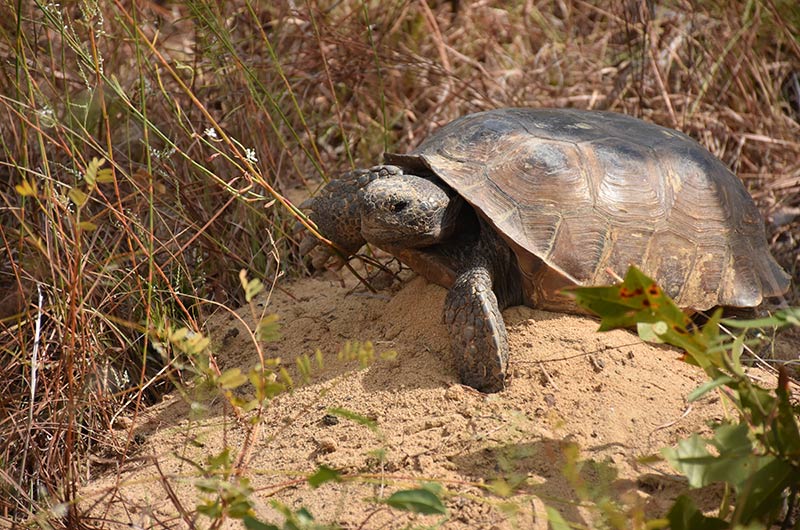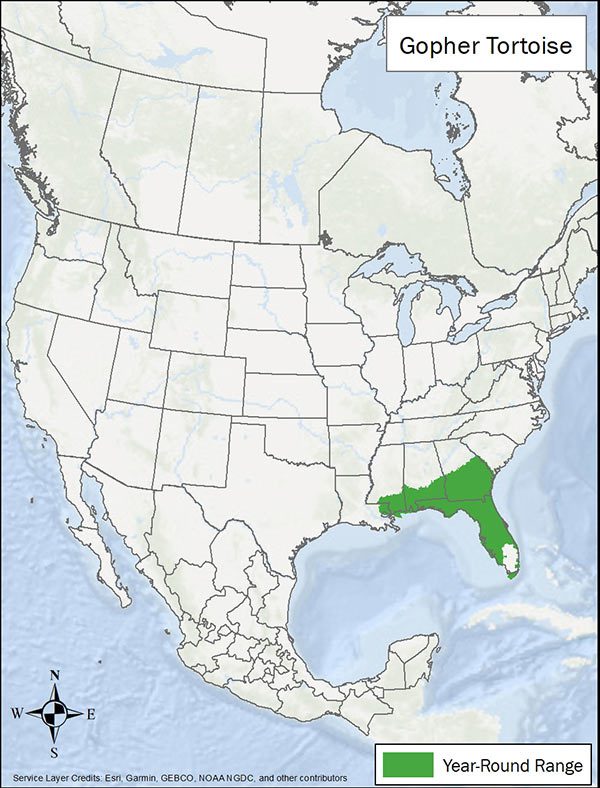LandPKS Learning
Habitat Hub

Gopher Tortoise
Gopher tortoises create their own burrows which are 3-52 ft/1-16 m long and 9-23 ft/3-7 m deep. More than 350 different kinds of animals are known to share burrows with gopher tortoises from lizards and toads to insects. Some including the six-lined racerunner, gopher frog, gopher mouse, and cave cricket are dependent upon the gopher tortoise burrows.
Gopherus polyphemus
Identification
Gopher tortoises are found in the southeastern United States. This moderate-sized turtle grows up to 15 in/38 cm and weighs 8-15 lbs/4-7 kg. The shell of adult tortoises is brown, gray, or tan, while young tortoise shells are yellow-orange and brown. The back legs are stumpy and elephantine, and the front legs are shovel-like and covered with large scales. Gopher tortoises can live up to 80 years in the wild. Females become sexually mature once their upper shell or carapace is 9-9.4 in/23-29 cm, often achieved at 9-11 years.
The gopher tortoise is considered Endangered in the western portion of its range in Alabama west of Tombigbee River, Mississippi and Louisiana. In the eastern portion of the range in Alabama, Georgia, South Carolina, and Florida, it is considered a candidate for possible listing under the Endangered Species Act.
Observation Tips
Gopher tortoises are found in many state and national parks, national forests across the southeastern United States. They spend most of their time underground in their burrows. The easiest time to view them is when they are warming in the sun near burrow entrances in late spring and summer.
Interesting Fact
Gopher tortoises create their own burrows which are 3-52 ft/1-16 m long and 9-23 ft/3-7 m deep. More than 350 different kinds of animals are known to share burrows with gopher tortoises from lizards and toads to insects. Some including the six-lined racerunner, gopher frog, gopher mouse, and cave cricket are dependent upon the gopher tortoise burrows.
Ideal Habitat
Gopher tortoises prefer relatively well-drained soils with ample herbaceous vegetation associated with longleaf pine and oak sandhills. They can dig burrows in a range of soil conditions from sandy, loamy, or sandy clay soils. They also inhabit pine-oak sandhills, sand pine scrub, dry hammocks, pine flatwoods, dry prairie, coastal grasslands and dunes, mixed hardwood-pine communities along roadways, and power right of ways. Ideal habitat is open with 30-50% tree cover with a wide variety of herbaceous ground cover. Open sunlit areas are needed for nesting and sunning/thermoregulation. Gopher tortoise primarily eat grasses and other herbaceous plants. They also eat insects, carrion, and fruits. More than 80% of gopher tortoise habitat is on private lands.

Range map provided by NatureServe
Management Activities that Benefit Species – Best Management Practices (BMPs)
Maintain intact longleaf pine and oak scrub habitats and restore the natural fire regime. Conduct prescribed burning every 2-7 years for longleaf pine and 15-30 years for sand pine scrub to maintain open habitats and reduce woody encroachment. Be careful when driving through gopher tortoise habitats to avoid direct mortality. Coordinated management of private and public landscapes will benefit gopher tortoises. Landowners can help by allowing monitoring, research, and reintroduction of tortoises on their land.
Management Activities to Avoid
Avoid conversion to agriculture or urban development. Avoid converting native forests to forest plantations. Dense forest plantations reduce sunlight reaching the ground and, therefore, grass growth.
Other Species that Benefit from Similar Habitat Management
Management for gopher tortoise benefits the red-cockaded woodpecker, Florida scrub-jay, eastern diamondback rattlesnake, dusky gopher frog, Florida mouse, Florida gopher snake, and eastern indigo snake. Hundreds of vertebrates and invertebrates use burrows. Armadillos, foxes, raccoons, skunks, and opossums prey upon tortoise eggs.
Download
Download the Gopher Tortoise factsheet
Descarga la ficha de Tortuga terrestre de Florida
Other Resources
Florida Fish and Wildlife Conservation Commission. Gopher Tortoise Program.
NatureServe. 2021. NatureServe Explorer: An online encyclopedia of life [web application]. Version 7.1. NatureServe, Arlington, Virginia. Gopher Tortoise
NRCS. Gopher Tortoise
USFWS. Gopher Tortoise
Photo credit: Florida Wildlife Commission/Flickr
Mobile App | Data Portal | Knowledge Hub | Habitat Hub | Learning Collections | Blog | About | Contact | Support



